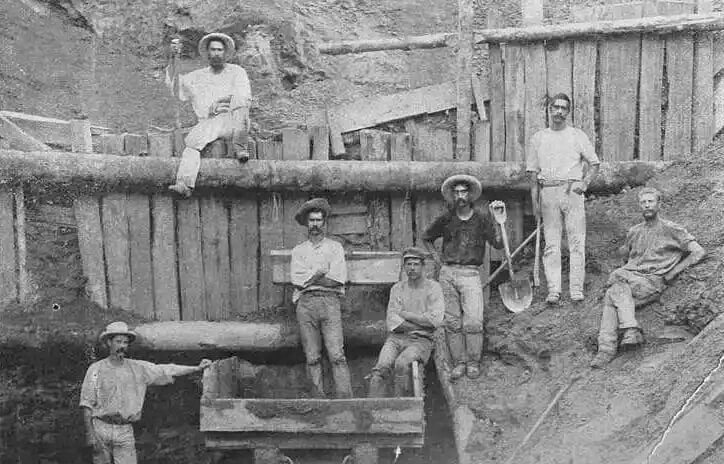
Group portrait of workmen on the Main Trunk Line extension at Poro-o-Tarao.
John Gough had been at work in the Poro-O-Tarao tunnel for about half an hour on a Saturday morning at the end of July in 1888 when one of the bricklayers asked him to make up some ‘compo’ – a mix of cement-lime-sand mortar. As he turned to get a trowel, the overhead timbers suddenly caved in, there was a heavy fall of earth and John was buried.
Ominously, John had written to relatives a week earlier saying while the men were at work in the tunnel, they saw what they thought were signs of the roof giving way and ran out, resuming work again shortly afterwards.
The Poro-O-Tarao tunnel was at the end of the main trunk railway line, being driven over 4000 feet through a hill. The work employed about 40 men. The first drive was almost through and timbered up. It was usual to remove the timber as the brickwork was built up, and timber was being taken down past the end of the brickwork when the accident occurred. Two men were injured, and Frank Smith, son of the brickwork contractor, was also buried by the fall of earth and roots, but managed to struggle out. His father took him to Waikato Hospital.
About 10am John was dug out but life was extinct. He was 52, married with several children, his wife and family residing in Sydney. He had come to New Zealand from Ireland when he was 20. He also spent some time in Australia before returning to New Zealand. Thirteen days previous to the accident John’s mother had died at Auckland.
Mr Adams, foreman, left Poro-O-Tarao on horseback as soon as the body was recovered. He rode into Te Kuiti around dusk and reported the matter to Constable Berriman who immediately started for Te Awamutu for the coroner. But he was absent in Auckland. A JP, Captain Rutherford, was found and he returned with the constable, a journey of 70 miles on horseback through the night, to hold the inquest at the tunnel early on Monday morning. A verdict was returned that John had been accidentally killed by a fall of earth, but that no-one was to blame.
John was taken to Te Kuiti on a sledge drawn by two horses over a bad road of 30 miles. Three men accompanied it, one walking in front with a light. The party arrived at Te Kuiti on Tuesday morning, when the coffin was put on the train for Te Awamutu, where it was left; pending instructions from John’s relatives in Auckland. Mr Briton, works manager, furnished funds for the burial either at Te Awamutu or Auckland. Constable Berriman was praised for the pains he took in getting the inquest held. He went to a great deal of trouble, not sparing himself in the execution of his duty, which, owing to the awful roads and the night travelling involved, was very arduous.
There was unrest over John’s death – 30y men left the works and went to Auckland by train alleging that the timbering in the tunnel was defective and dangerous, and that it had shown signs of giving way for some time. Mr Briton, known as a man of great skill and experience in works of this character, denied this but the fact that a number of men walked off, especially when employment was so difficult to obtain, was seen as a matter for inquiry.
John, usually resident at Auckland, was buried at Rangiaowhia, about 4 km east of Te Awamutu.
The Poro-O-Tarao tunnel works were put through an area of 23 sacred Māori healing trees and other tapu sites. Te Ihingārangi were promised the railway would go round the area and tapu poles were put in the railway’s path by tohunga but the grove was felled before the tapu could be removed. Construction of the tunnel was beset with difficulties including fire, earth collapses, serious injuries, death, strikes, and one contractor giving up in despair when problems proved too great to cope with.









